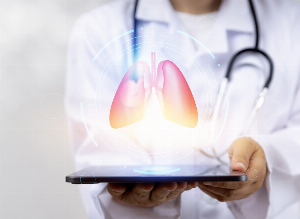What are the different types of lung cancer? How are they diagnosed and treated?
Published Oct 14, 2021 • By Claudia Lima
In the US, lung cancer is one of the most common cancers, both in men and, increasingly, in women. A distinction is made between "small cell" and "non-small cell" lung cancers.
How are they diagnosed? How are they treated?
We answer these questions and more in our article!

Lung cancer, also known as bronchial carcinoma, is a condition affecting bronchial cells. It is a severe disease, usually diagnosed in adults who have been exposed to cigarette smoke. There are two major forms of lung cancer: small-cell lung cancer, and non-small-cell lung cancer. Other forms exist, but they are much more rare.
Let us remind you that the role of lungs is to ensure the exchange of carbonic gas and oxygen between human body and the surrounding air.
What is the prevalence of lung cancer in the US?
Lung cancer is the 3rd most common cancer in the US. More people in the United States die from lung cancer than from any other type of cancer. Approximately 541,000 Americans living today have been diagnosed with lung cancer at some point in their lives.
The lung cancer five-year survival rate is 20%, which is lower than many other common types of cancer.
The rate of new lung cancer cases over the past 42 years has decreased by 36% for men while it has increased by 84% for women. The number of deaths from lung cancer also continues do drop.
What causes lung cancer?
Tobacco smoking is the main risk factor for lung cancer. It is responsible for 80 to 90 % of lung cancer cases.
Numerous studies have shown, that the period of time during which one has been smoking, is more important than the quantity of tobacco consumed daily, which means that smoking a little, but every day and for a long period of time, is more harmful, than smoking a lot but during a smaller period of time.
Also, passive smoking increases the risk of developing lung cancer by 20 %.
Professional exposure is also one of the causes, the most common exposure being to asbestos, but also to arsenic, nickel and chromium, among others. These are substances officially recognized as human carcinogens.
Air pollution can also increase the risk of cancer, but it is the estimated cause of only 1-2% of cases.
For now, no genetic predisposition for cancer has been identified, but a link to personal or family medical history can sometimes be found (Chronic obstructive pulmonary disease, or COPD, tuberculosis, etc..).
What are the symptoms and the diagnosis of lung cancer?
Symptoms and signs may vary, they can depend directly on the tumor or its development, or may be related to metastatic diffusion of the tumor into other parts of the body.
The most common symptoms are:
- Headaches, weight loss, coughing,,
- Bronchitis or persistent pneumonias,
- Difficulties swallowing,
- Bone pain, chest pain,
- A hoarse voice, wheezing,
- Pleural effusion or pulmonary edema (accumulation of liquid in lungs/pleura),
- Breathlessness, shortness of breath,
- Fatigue, weakness,
- Hemoptysis (coughing up blood).
At the apparition of one or more symptoms, your doctor will be able to prescribe you a chest radiograph (X-ray) and/or a CT scan in order to establish a diagnosis. He or she will determine the stage of the disease and will start the treatment which will aim at increasing your lifespan as much as possible.
Various tests and examinations allow to confirm the presence of a tumor and to assess the extent of the disease.
Biopsy allows to determine the type of cancer (small-cell cancer, non-small-cell cancer, etc.). Medical imaging is used to identify the lesions present in the body, in order to define the best possible therapeutic strategy.
What are the different types of lung cancer and their stages?
There are two main groups:
- Non-small-cell lung carcinoma (NSCLC), which represents more than 80 % of lung cancers, the main subtypes being adenocarcinoma (40%), squamous-cell carcinoma (from 25 to 30%), large-cell carcinoma (from 10 to 15%),
- Small-cell lung carcinoma (SCLC), which represents 10 to 15% of lung cancer cases.
Different stages of lung cancer
Clinical classification for the majority of cancers is established according to the size of the tumor (T), lymph node involvement (N) and distant metastasis (M).
For NSCLC, tumors are then classified according to 5 stages, from 0 to 4, the higher the stage, the more extended the disease is.
For SCLC, the TNM classification is not really used, and another method was chosen which divides the disease in two stages: the limited stage, one half of the chest is affected, or the extended stage, when cancer has spread outside the damaged lung.
Some tumors can undergo a particular genetic mutation. The analysis of these specific genetic markers, also called biomarkers, helps to make targeted and appropriate therapeutic decisions. The main genetic mutations in lung cancer are located on KRAS, EGFR and ALK genes.
What are the treatments for each type of lung cancer?
Lung cancer has a chronic disease status, which means that the care plan covers the treatment and personal support, adaptation and anticipation of care. Therefore, medical professionals, caregivers and social services all work together to improve care efficiency and patients' quality of life.
Treatment for NSCLC
The only curative treatment, combined with chemotherapy and radiotherapy, is tumor removal (when it is possible), also called tumor resection surgery. Tumor resection surgery depends on the size and location of the tumor, and is becoming less and less invasive.
The surgery is performed for stages I, II and sometimes III. Depending on the status of biomarkers, other targeted therapies, such as immunotherapy, are a possible solution before or after the surgery.
For stages III and IV that are inoperable, chemotherapy and/or radiotherapy are prescribed. Immunotherapy is also a possibility.
Treatment for SCLC
Due to rapid dissemination of cells in the body, surgery is very seldom indicated for this type of cancer. For localized forms, treatment is based on chemotherapy and radiotherapy.
If treatment is efficient, it can lead to remission: tumors are eliminated and the patient is recovering. Cancer recurrence is possible, especially if the pathogenic agents that caused the disease are still present. Patient's follow-up care plan is set up in order to detect a possible recurrence.
Almost 40% of the NSCLC cases and 80% of the SCLC ones are diagnosed when metastasis are already present.
And what next? Follow-up care
Once the disease is treated, a follow-up care plan is set up, with checkups every 3-4 months and a CT scan of the thorax every 6 months during the first year, then annual follow-up visits are organized.
Due to the side-effects of administered treatments, nutritional support is recommended in order to prevent, detect or treat malnutrition, or, on the contrary, excess weight.
Psychological aspect also needs to be taken into account. Living with cancer, from the moment of the diagnosis, is overwhelming, and psychological counseling can be necessary. Support groups bringing together people with similar situations can also be useful and comforting.
Quitting smoking for the period of treatment is always beneficial. It has a positive impact on treatment tolerance and disease prognosis.
Last but not least, an appropriate physical activity can improve patient's quality of life during the period of treatment, as well as their response to treatment.
Research is carried out in order to find ways to improve care for patients with lung cancer. Multiple ongoing clinical studies show the dynamism of current research. Personalized medicine is now a preferred approach to treating patients with advanced or metastatic lung cancer.
It is important to remember that smoking is the main risk factor and that any inexplicable symptom should evoke lung cancer and be a reason for a complete check-up as soon as possible
Give it a like or share your thoughts and questions with the community in the comments below!
Take care!
Sources:
- Le cancer du poumon, dossier pédagogique, curie.fr
- Cancer du poumon, symptômes, diagnostic et traitement, roche.fr
- Cancer du poumon, points-clés, e-cancer.fr
- Comprendre le cancer du poumon, frm.org
- Les cancers du poumon, fondation-arc.org
- Panorama des cancers en France, e-cancer.fr
- Les facteurs des risques du cancer du poumon, fondation-arc.org
- Espérance de vie et stades des cancers du poumon, radiotherapie-hartmann.fr
- Cancer du poumon non à petites cellules, esmo.org
- Cancer du poumon, troubles pulmonaires, msdmanuals.com
- Lung cancer fact sheet
- Key statistics for lung cancer
- Lung and bronchus: at a glance

 Facebook
Facebook Twitter
Twitter


